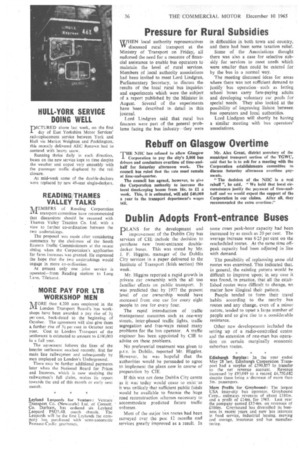Dublin Adopts Front-entrance Buses
Page 38

If you've noticed an error in this article please click here to report it so we can fix it.
DLANS for the development and / improvement of the Dublin City bus services of CIE include the decision to purchase new front-entrance doubledecker buses. This was stated by Mr. J. F. Higgins. manager of the Dublin City services in a paper delivered to the Institute of Transport (Irish section) this week.
Mr. Higgins reported a rapid growth in private car ownership with the all too familiar effects on public transport. It was predicted that by 1977 the present level of car ownership would have increased from one car for every eight people to one for every four.
The rapid introduction of traffic management measures such as one-way streets, inter-phased traffic lights, traffic segregation and free-ways raised many problems for the bus operator. A traffic engineer has been appointed by CIE to advise on these problems.
No preferential treatment was given to p.s.v. in Dublin, reported Mr. Higgins. However, he was hopeful that the authorities would be persuaded to agree to implement the plans now in course of preparation by CIE.
If this was not done Dublin City centre as it was today would cease to exist • as it was unlikely that sufficient public funds would be available to finance the huge road reconstruction schemes necessary to accommodate predicted future traffic volumes.
Most of the major bus routes had been surveyed over the past 12 months and services greatly improved as a result. In
some cases peak-hour capacity had been increased by as much as 20 per cent. The average increase was 6.25 per cent on the rescheduled routes. At the same time offpeak capacity had been adjusted in line with demand.
The possibility of replanning some old routes was examined. This indicated that.
in general, the existing pattern would be difficult to improve upon; in any case it was found, in practice. that all the established routes were difficult to change. no matter how illogical their pattern.
People tended to form their travel habits according to the nearby bus routes and any change, even of a minor nature, tended to upset a large number of people and so give rise to a considerable resistance.
Other new developments included the setting up of a radio-controlled centre and the extension of one-man bus operation on certain marginally economic
suburban routes.
Edinburgh Surplus: In the year ended May 28 last, Edinburgh Corporation Transport had a surplus of £390,85/ to transfer to the net revenue account. Revenue increased by £93,049 to a record £4,750,682 despite there being a 'decrease of more than 5m. passengers.
More Profits for Greyhound: The largest USA inter-city bus operator, Greyhound Corp., estimates revenues of about £180m. and a profit of £14m. for 1965. Last year the company earned £13.4m. on revenues of £166m. Greyhound has diversified its business in recent years and now has interests in food service, industrial leasing, moving and storage, insurance and bus manufacturing.




























































































































